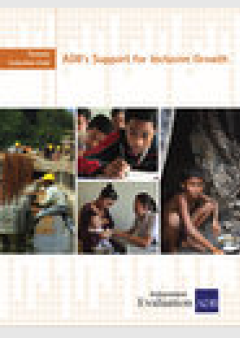
ADB's Support for Inclusive Growth
Impressive economic gains in Asia and the Pacific are otherwise diminished by still widespread poverty and growing inequality, calling for urgent implementation of inclusive growth approaches among the region's countries, says a new study.
Nearly 750 million people in the region still survive on less than $1.25 a day, while income inequality has risen more than 20% in the last 20 years. These levels hinder further economic advancement and even threaten the sustainability of an otherwise sharp reduction in poverty, according to a just-released study on ADB's Support for Inclusive Growth by Independent Evaluation at the Asian Development Bank (ADB).
Development organizations such as ADB, for their part, can step up efforts to integrate inclusive growth into their development strategies, says the study. ADB adopted inclusive growth as a strategic agenda in 2008, and seeks strong progress in making it an operational reality, it says.
"Inclusive growth is more than a desirable goal. By tapping the contribution of the lower-income groups as well, it becomes an essential ally for sustaining growth itself,” says Vinod Thomas, director general of Independent Evaluation.
A part of the problem is that lower-income groups have inadequate access to basic services in health care, education, or safe drinking water and sanitation. Case studies from Pakistan, the Philippines and Viet Nam in the new report well illustrate this skewed distribution of services. The quality of these services also matters for inclusive growth.
At the same time, overall growth has failed to translate into similar improvements in average living standards. One of the indications that growth is not reaching a broad enough segment of the population is relatively weak household consumption. According to the study's estimates, household consumption grew 5.7% annually in the 1990s in the region and 5.5% in the 2000s, well below gross domestic product growth of 9.0% and 8.2% in the two decades.
This is troublesome for countries attempting to expand domestic consumption as part of efforts to raise their economies to new levels of development and bring the benefits of growth to more people.
"Eliminating poverty in the region remains a major piece of unfinished business. Growing first and addressing social inclusion later does not seem appropriate any longer,” says Hyun Hwa Son, the principal author of the report.
The new report calls for efforts to forge better coordination and synergies among development organizations. It also pays to tailor inclusive approaches to the specific contexts and needs of countries because one size does not fit all. There is a clear need to go beyond simply financing projects, and toward integrating inclusion objectives into the design and selection of projects and country programs.
Among infrastructure interventions, for example, benefits accruing to lower-income groups can help promote inclusion. In Bangladesh, where major rivers have frequently separated the haves from the have-nots, the ADB-supported Jamuna Bridge project linked the poorer western and richer eastern regions of the country, and in doing so helped link more than 30 million people to the main transport and infrastructure network.
In the Philippines, the conditional cash transfer scheme called the Pantawid Pamilya Pilipino Program—providing a maximum annual cash grant of about $350 a year for a family with three school-age children if it meets conditionalities linked to education and health—by 2013 had registered 3.9 million households since 2008. The program has seen school participation rates increase and health improve among the target group. To ensure safety net programs like this contribute to inclusive growth, proper targeting is vital.
"Economic growth alone is not sufficient to improve people's welfare: we need complementary measures to help translate growth into commensurate improvements in living standards. The best way to do that is to include progressively lower-income strata in the growth process,” says Thomas.
